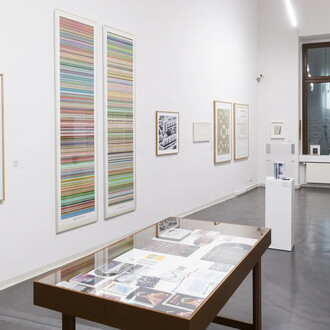The artist Malte Zenses (1987) presents Alte eichen, neue bilder. a special exhibition featuring paintings and sculptures, all created specifically for the exhibition at G2 Schaulager.
Zenses’ paintings are discourses on abstraction and figuration. Often, gesture dominates his work, appearing intuitive yet thoughtfully discursive. Zenses plays with codes from painterly elements and contemporary references, which he condenses into multi-layered compositions. This creates an independent painterly language, the deciphering of which can yield ambivalent results. Headlines or newspaper logos frequently appear, concretizing the works without directing them in a specific way. Often, the paintings are related to text fragments located at the bottom of the images, which are quotes from feature films. These introduce a poetic, literary dimension to the images, evoking associations and imaginations related to theatrical and dramatic elements, creating fragmented narratives and dialogues between the works. The textual level should not be understood as descriptions of the pictorial level; they coexist and can be read together or separately. The dialogue pieces are the last statements characters say in films before a catastrophe occurs. Zenses captures these moments when everything is still fine, the catastrophe sometimes already hinted at, and in the next moment, everything changes. Sometimes the painterly component penetrates the images much more. The result is powerful, dynamic compositions that oscillate between abstraction and landscape figuration.
In this exhibition, Zenses stages a punk concert by the fictional band chaos kadetts. The recordings heard are from a performance that takes place during the exhibition’s opening. The band’s lyrics, consisting of musician Vida Vojic and a sculpture named Jutta, seated on an amplifier by Zenses, are written by the artist. Zenses simultaneously creates performance, installation, and concert, evoking associations with scene movements that, alongside music, find expression in clothing, desires, wishes, and fears.
Zenses’ sculpture is dominated by textiles. Patches are sewn together, creating large, confusing surfaces that form a unit from fragments, like a collage. These lie over an unknown, concealed content, on a framework depicting bodily forms. The figure remains anonymous, faceless, and avoids our gaze. Often, the figures are bent over, seemingly seeking protection from something and wanting to obscure their identity. They appear like inhabitants of an urban, apocalyptic habitat, and it remains unclear whether something still exists beneath the surface or if they are just shells or relics of something past.
The exhibition introduces us to Zenses’ extensive work, driven by the idea of formulating themes precisely and openly, regardless of technique and material. In addition to concrete references to art history, pop and scene culture, and mass media, Zenses creates his own pictorial language system, complementing direct references and creating a multi-layered landscape of reception.















